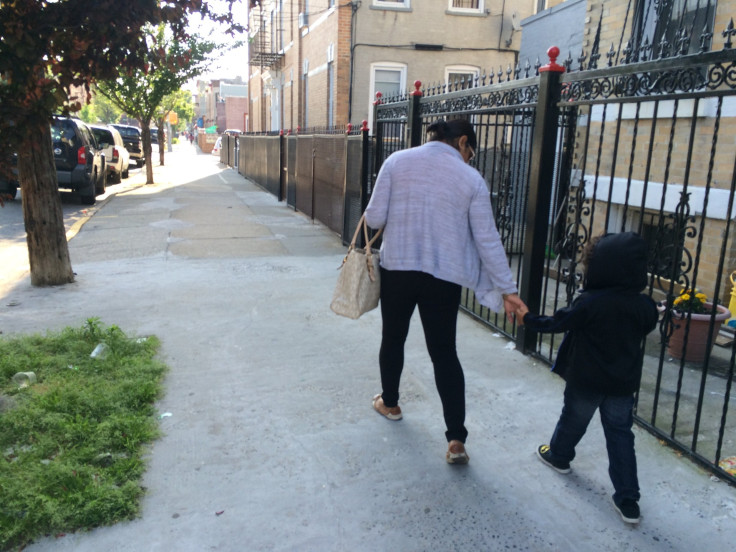Election 2016: How Soaring Child Care Costs Hurt Working Families

The sun is peeking through the front windows as Elizabeth Shiwdin wakes up early one hot morning in her Brooklyn, New York, home. She pushes herself up from the living room couch where she sleeps each night and quietly walks into the house’s one bedroom, reserved for her 4-year-old son, Kaelan Hicks. She picks him up from the full-size bed where he sleeps alone, stretching his small limbs across the sheets, and gets him dressed for the day in jeans and a favorite soft sweatshirt.
The two make their way out of the house by 8 a.m. and Shiwdin reaches down to take Kaelan’s hand as she closes their front gate behind them. She runs her fingers through Kaelan's soft, curly hair and thanks him for a “no fuss” morning so she can get to work on time after dropping him off at day care.
She wants to get in as many hours as possible. Her $700 rent was technically due the day before, but she has about $200 in her savings account and $190 in her checking account. A $300 paycheck will come at the end of the week, but it's not enough to cover her rent and weekly child care bill.
“It’s very frustrating and very depressing sometimes,” Shiwdin said. “It’s a lot, but it’s also a sacrifice you have to make.”

Shiwdin is one of the nearly 10 million single mothers in the United States who balance finding work with caring for their children. Over the past 25 years, the out-of-pocket cost of child care has nearly doubled, while wages have stagnated and women have entered the workforce in record numbers, driving the need for child care to its highest point. But even as the nation debates voting a mother into the White House for the first time ever, one of the biggest issues facing women has received relatively little attention on the campaign trail, signaling that family economics are largely still considered personal matters rather than public policy.
Many of the work-family policies in the United States were created at a time when most families had full-time caregivers, often the mother. But family structures have changed — 64 percent of mothers with children under 6 now have jobs, up from 32 percent in 1975, and 65 percent of children under 6 live in homes where all parents are in the labor force.
At the same time family structures were changing, costs were soaring. Adjusting for inflation, average weekly child care expenses for families with working mothers rose from $84 per week in 1985 to $143 per week in 2011 — an increase of 170 percent, according to research by the Census Bureau. Americans also saw their wages stagnate and decline in purchasing power, compounding the problem of rising costs.
The cost of child care varies widely by area, but at the top, it can reach more than $16,000 per year in parts of Massachusetts. In California, parents pay an average of $11,628 a year and in Colorado it costs an average of $13,154, according to Child Child Care Aware of America, an organization that provides research and resources about the child care system. For a family with an infant and a preschooler, the cost of care in a child care center exceeds the annual median rent price in every state. Put another way, the average annual cost of infant care is higher than the cost of public four-year college in two-thirds of states.
“As incomes have stagnated, and you think about the cost for one child let alone two or three, the costs are staggering and there is a real sense of crisis in the state,” said Betty Holcomb, the policy director for the Center for Children’s Initiatives, a child care resource and referral agency in New York City.
The lack of access to affordable child care can keep women out of the workforce and hurt businesses’ bottom lines. Other countries with more generous child care and family leave policies have seen positive effects on their economies, and the Department of Labor estimates that if similar policies were enacted here, there would be 5 million more women in the U.S. workforce, which would result in more than $500 billion of additional economic activity per year.
The average annual cost of infant care is higher than the cost of public four-year college in two-thirds of states.
Family economic issues have traditionally been viewed as an individual responsibility in the United States, but advocacy and research is starting to change that, experts said. A poll conducted last year for child advocacy organization Save the Children Action Network found that 71 percent of voters in presidential battleground states support increasing access to and improving the quality of early childhood education programs, even if it means a slight tax increase. And a poll released this month by the Center for American Progress found that an overwhelming number of black and Hispanic women see improving the well-being of working families as a key priority for the country’s next president.
Presumptive Democratic nominee Hillary Clinton, the nation's first female presidential candidate from a major political party, announced a plan in May to address the rising costs of child care. Her proposal would boost a “home visiting” program that sends social workers and nurses to help low-income children and would increase wages for child care workers as a way to recruit and retain more highly qualified educators. The most ambitious aspect of her plan was a promise to cap child care expenses at 10 percent of a household’s income.
Her campaign said she would accomplish this through a combination of subsidized care and tax credits, which sounds similar to a proposal last year from the Center for American Progress, a liberal think tank in Washington, D.C., with close ties to Clinton. In its proposal, CAP recommended creating a new child care tax credit that would give families up to $14,000 per child. It would be advanced to families on a monthly basis and paid directly to child care providers, while child care centers would be required to meet state quality standards to receive federal funding.
“It’s a huge economic issue," said Katie Hamm, one of the authors of the CAP proposal. "On the one hand it’s a micro family budget issue, but on the other hand it’s a problem for our workforce. Looking at our long-term competitiveness, if children are not getting a strong foundation from high-quality child care, we’re not going to be able to compete with other countries where the children are getting that care.”

To cope with these high costs, the federal government provides some assistance to low-income families purchasing child care. Most of the federal funding for child care comes from the Child Care and Development Block Grant, which was reauthorized in 2014 for the first time since 1996. This reauthorization created a host of new protections and quality standards for child care, but did not significantly increase the program’s funding.
The amount of money available for assistance has never covered all families who need help. Of the 1.42 million children eligible for child care subsidies under federal rules in 2012, the most recent year for which data is available, just 15 percent received subsidized care.
For Jodi Ballard-Beach, a mother of two in Portland, Oregon, child care payments have seen her family go into credit card debt. She makes $90,000 per year working in human resources for the county government and her husband makes $39,000 per year at a local nonprofit, so they do not qualify for any subsidies, she said. But with Oregon being one of the most expensive states in the country for child care, Ballard-Beach pays more in child care costs each month (around $1,700) than she does on her mortgage ($1,350).
“The part that’s so frustrating is that my husband and I both have master’s degrees, we’re successful. We’re doing well. But we’re stuck in this really hard place because of child care and we can’t dig ourselves out of it,” she said.
Ballard-Beach said she chose the day care center closest to her office that provided the longest hours of care. But she and her husband share one car, and now that her son is in kindergarten and her daughter is still at the day care center, Ballard-Beach said she is often scrambling to pick up both children before 6 p.m., after which the day care charges $1 for every minute they are late.
They considered having one parent stay home instead of paying for child care, but on top of the $20,000 loan she and her husband took out to consolidate their credit card debt, Ballard-Beach said they are still paying off student loans, which cost $450 each month and could increase to more than $1,000 by the end of this year.
“We have no idea what we’re going to do. There’s no way for us to pay child care and student loans,” Ballard-Beach said.
When parents do qualify for assistance, the situation is not guaranteed to be any easier. Shiwdin, the mother from Brooklyn, makes about $31,000 a year at her job as a supervisor at Burlington Coat Factory, which puts her right up against the maximum income ceiling for child care assistance in New York. If she gets a raise or a promotion, she could easily be bumped over the top and lose her subsidy.
While Shiwdin’s subsidy allows her to pay $110 per week to the Cypress Hills Child Care Center where she takes her son, her weekly paycheck of about $300 means this is still a heavy burden for her.
“As a single parent, they don’t take into consideration that you have to pay rent, you have to pay bills, you have to eat. It’s not like you’re just doing that one thing with your money,” she said.
Cypress Hills allows Shiwdin to drop off her son, Kaelan, before she goes to work, but in the evenings, she often doesn’t get home from work until 7 p.m. She pays her aunt or uncle to pick him up at 4:30 p.m., when child care ends, adding to her costs.
Shiwdin has had to cut back on other expenses just to pay her bills, she said. She got rid of her home phone and stopped paying for cable a few months ago, and she often saves up to buy clothing at the store where she works when they have holiday sales. That way, Shiwdin said, she can buy clothes her son will grow into and put items on layaway so she has time to pay them off.
“We don’t get to do extra stuff like a normal family. In the summer I can’t take him to the water park, I can’t take him to places because I can’t afford it and it’s expensive,” Shiwdin said.
After coming home from child care on a recent day, Kaelan climbed up on a wooden table in the narrow, concrete-floored backyard behind his home.
“Mom, I want to fly!” Kaelan declared, wearing a Spider-Man shirt, blue jeans and shoes emblazoned with the Batman logo.
“Don’t do that,” his mother warned.
“But I’m a superhero!” the 4-year-old shouted back.
“I know you’re a superhero, but you’re gonna get hurt. Superhero gets hurt too, and you’re gonna have to go to the hospital,” Shiwdin cautioned.
Her eyes tightened. She gets health insurance through her job, but if her son were to break a leg or even simply get sick, that could mean she’d need to take time off work to care for him, losing money in addition to sleep over Kaelan’s health. Even if Kaelan doesn’t attend child care for a day, Shiwdin still has to pay the full $110 every week.
“No they don’t!” Kaelan said with a big grin, before jumping from the table safely onto the ground, landing with a thud as his mother shook her head and laughed in relief.
Rosmely Akers, another mother in New York, put her 4-year-old son, Evan, in day care last fall, but she had to pull him out in April because her husband lost his job as a correction officer. Without his full-time job, the family no longer qualified for their subsidy. Akers, who is originally from the Dominican Republic, makes $150 a week working part time in a hair salon and takes English as a second language classes a few days a week. She hopes to get a degree as a pharmacy technician, but that will take years.
She is concerned that Evan is no longer in school, because she wants him to be prepared for kindergarten, but the situation is also making it difficult for her husband to find a new job, the one thing that would allow them to put their son back in child care.
“My husband, if he has an interview, I would have to take off or find someone to watch the child until he comes back from the interview,” Akers said. “When he was in the day care he was learning, he was learning the colors and being around other kids. Right now, he’s here all day with my husband in the little apartment and he’s making my husband crazy and making me crazy.”
Even if parents can afford day care, they may get stuck on waiting lists if child care programs near them are full. There is a particular shortage of spots for 2- and 3-year-olds, said Moria Cappio, vice president for early childhood programs at the Children’s Aid Society, which provides social services, including child care, to low-income kids and families in New York City. With the push for more cities and states to adopt universal pre-K, there are often more options available for 4-year-olds, but before children reach that age, care is more expensive and fewer funding options exist.
“A lot of times that poor little kiddo is sitting on the couch with grandma watching TV for most of the day,” Cappio said.

Parents, providers and advocates in the child care industry all agree that having high-quality care is vital. Research has shown that access to high-quality child care prepares children to succeed in school and boosts parents’ participation in the workforce as well as their productivity, making this an issue of national interest, child care advocates argue.
However, child care providers worry that quality standards have increased in recent years without adequate funding support. For example, the requirements for offering infant care in New York include needing one teacher for every three babies and space to place the babies’ cribs a certain number of feet apart. In places like New York City with high real estate prices, those regulations make it cost-prohibitive for many child care centers to offer infant spots, said Maria Collier, director of Cypress Hills Child Care Corp., which owns the center where Shiwdin takes her son.
“I’m all for increasing the standard. But quality costs money and you cannot expect to be adding requirements and additional trainings and not have that be reflected in your budget,” Collier said.
With constrained costs come limited salaries for child care workers. Child care workers make far less than their counterparts in other levels of education, and often less than hourly wage-earners in other professions. Part of Clinton’s child care proposal is aimed at increasing wages for child care workers. Her rival during the Democratic presidential primary, Bernie Sanders, also called the country’s low child care wages “an embarrassment.” Presumptive Republican nominee Donald Trump has a different attitude, emphasizing that he does not like hands-on parenting and believes wages in general are already “too high.”
“At the time when the cost of child care is the most, we give parents the least support. In school, we give that to parents because it’s defined as a public good, but we haven’t made that determination for child care,” said Marcy Whitebook, director of the Berkeley Center for the Study of Child Care Employment. Whitebook said the public conversation needs to be focused on both access to child care and quality education.

At Cypress Hills Child Care Center in Brooklyn, where Shiwdin sends her son, she said the teachers are smart and kind, and she feels confident Kaelan will be well prepared for his future.
After nearly eight hours of working the sales floor at her job, she takes the 45-minute subway ride back to East New York, where she picks up Kaelan from her aunt’s house, brings him home and lets him run around their small backyard until it's dark.
Back inside, she slips out of her sandals and lets her son play games on a tablet until she convinces him to go to bed around 9:30 p.m. With most of the lights already off, Shiwdin bends to pick up a Spider-Man action figure, a stuffed dog and a light-up robot, putting them one by one back in the toy box that sits under a shelf of family photographs in the center of the living room.
“I already lived my life," she said. "So it’s pretty much all about him now.”
© Copyright IBTimes 2024. All rights reserved.





















